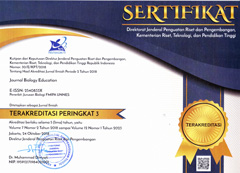Implementation of the Concept Attainment Learning Model to Increase Independence and Reduce Misconceptions of MA Students on the Circulatory System' Learning Material
Abstract
Misconception is an understanding that is not in accordance with the concept conveyed by experts. Misconceptions are still found in student learning outcomes on the Circulatory System material. The Concept Attainment Model is a teaching strategy that helps students strengthen their understanding of the concepts being studied. Learning independence is one of the factors that influence learning outcomes. The purpose of this study was to increase student independence and learning outcomes as well as reduce students' misconceptions about the Circulatory System material. This research is a pre-experimental research with a one group pretest-posttest design. The data in this study were obtained through observation sheets, student response questionnaires, pretest-posttest, and student interviews. The results showed that prior to the implementation of the Concept Attainment learning model, students' learning independence was classified in the medium category. After the implementation of the Concept Attainment learning model, student learning independence increased, belonging to the high category. Student learning outcomes show that prior to the implementation of the Concept Attainment learning model, they had not reached the specified classical mastery. That is, student learning outcomes are low. After implementing the Concept Attainment learning model, student learning outcomes experienced a good increase in the medium and high N-Gain categories. The findings of students' misconceptions prior to the implementation of the Concept Attainment learning model were found in the concept of the mechanism of the clotting process, the link between blood type and blood transfusion, parts of the heart in cardiac anatomy, differences in the systemic and pulmonary circulatory systems, and disorders/abnormalities of the circulatory system. After implementing the Concept Attainment learning model, misconception were found in the concept of blood constituent components, the relationship between blood type and blood transfusion, and disorders/abnormalities of the circulatory system. Thus, it can be concluded that the implementation of the Concept Attainment learning model can increase student independence and learning outcomes and reduce student misconceptions.
The copyright of the article once it is accepted for publication shall be assigned to the journal as the publisher. The intended copyright includes the right to publish the article in various forms (including reprints). The journal maintains the publishing rights to the published articles.
This work is licensed under a Creative Commons Attribution 4.0 International License.







